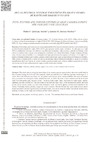Please use this identifier to cite or link to this item:
https://accedacris.ulpgc.es/handle/10553/114157
| Title: | Ollas, olleros, olleras y ollerías en Gran Canaria durante los siglos XVI y XVII | Other Titles: | Pots, potters and potter centres in Gran Canaria during the 16th and 17th centuries | Authors: | Quintana Andrés, Pedro J. Jiménez Medina, Antonio M. |
UNESCO Clasification: | 550404 Historia moderna 550302 Historia regional 550502 Ciencia de la cerámica |
Keywords: | Cerámica Alfares Olleros Siglo XVI Siglo XVII, et al |
Issue Date: | 2021 | Publisher: | Cabildo Insular de Gran Canaria | Conference: | XXIV Coloquio de Historia Canario-Americana | Abstract: | Este trabajo pretende acercar el conocimiento de los talleres productores de cerámica que se establecieron en Gran Canaria durante los siglos XVI y XVII, que aparecen citados como «ollerías». Se sabe que en el siglo XVI se establecieron al menos seis olleros y una ollera que fabricaban «ollas canarias», además de elaborar tanto a torno y a molde, como a mano, otros recipientes y elementos con «barro de la tierra» (tinajas, tinajones, formas, sinos, atanores, tejas y ladrillos). Los principales encargos procedían de los ingenios azucareros. En el siglo XVII destaca el trabajo realizado por mujeres, quienes elaboraban búcaros (que se exportaban a la Península), lebrillos, tallas, jarros y cuarteroncitos. A pesar de que se documentan piezas cerámicas elaboradas a mano en contextos arqueológicos de Gran Canaria, no existen estudios pormenorizados que incluyan análisis arqueométricos sobre las mismas, por lo que se desconoce el origen y evolución de esta artesanía. This work aims to bring the knowledge of the ceramic producing workshops that were established in Gran Canaria during the 16th and 17th centuries, which are referred to as «ollerías» (pottery workshops). It is known that in the 16th century at least six men potters and a woman potter were established that made «Canarian pots», in addition to making both lathe (wheel) and mold, as well as by hand, other containers and elements with «clay from the earth» (jars, big jars, forms - molds to make sugar-, sinos -big molds to make sugar-, spouts-pipelines, roof tiles and bricks). The main orders came from the sugar mills. In the seventeenth century, the work carried out by women stands out, who made «búcaros» -small red smelly glasses- (which were exported to the Iberian Peninsula), basins, pitchers, mugs and «small quarters». Despite the fact that hand-made ceramic pieces are documented in archaeological contexts in Gran Canaria, there are no detailed studies that include archeometric analyzes on them, so the origin and evolution of this craft is unknown. |
URI: | https://accedacris.ulpgc.es/handle/10553/114157 | ISSN: | 2386-6837 | Source: | XXIV Coloquio de Historia Canario-Americana [ISSN 2386-6837] |
| Appears in Collections: | Actas de congresos |
Page view(s)
175
checked on Nov 1, 2024
Download(s)
225
checked on Nov 1, 2024
Google ScholarTM
Check
Share
Export metadata
Items in accedaCRIS are protected by copyright, with all rights reserved, unless otherwise indicated.
